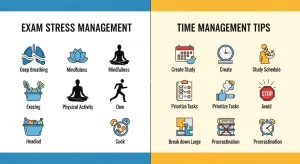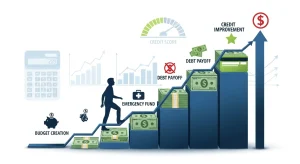Understanding credit scores is essential for achieving financial success and accessing the best lending opportunities in today’s economy. Your credit score serves as a financial report card that lenders use to evaluate your creditworthiness, affecting everything from mortgage rates to credit card approvals and even employment opportunities.
Whether you’re new to credit or looking to improve your existing credit rating, this comprehensive guide will demystify the world of credit scoring and provide you with actionable strategies to build and maintain excellent credit. With the right knowledge about FICO scores, VantageScore, and credit factors, you can take control of your financial future.
How a Student Achieved Fluent English in One Year Without Moving Abroad
What Is a Credit Score and Why Does It Matter?
A credit score is a three-digit number that represents your creditworthiness based on your credit history and financial behavior. This numerical representation helps lenders quickly assess the risk of lending you money or extending credit.
The Financial Impact of Credit Scores
Understanding credit scores reveals their significant impact on your financial life:
- Interest Rates: Higher credit scores qualify for lower interest rates on loans and credit cards
- Loan Approval: Better scores increase approval odds for mortgages, auto loans, and personal loans
- Insurance Premiums: Many insurers use credit scores to determine insurance rates
- Employment Opportunities: Some employers check credit scores during hiring processes
- Rental Applications: Landlords often require good credit scores for apartment approvals
Credit Score Ranges: What Your Number Means
Credit score ranges help you understand where you stand financially:
| Score Range | Credit Rating | Lending Impact |
|---|---|---|
| 800-850 | Excellent | Best rates and terms available |
| 740-799 | Very Good | Access to favorable rates |
| 670-739 | Good | Most lenders will approve |
| 580-669 | Fair | Higher rates, limited options |
| 300-579 | Poor | Difficult approval, very high rates |
Understanding these ranges helps you set realistic goals for credit score improvement and recognize when you’ve achieved excellent credit status.
8 Common Mistakes That Kill Your Productivity
FICO Score vs VantageScore: Understanding the Differences
The two main credit scoring models used today are FICO scores and VantageScore, each with unique characteristics:
FICO Score Overview
FICO scores consider payment history (35%), amounts owed (30%), length of credit history (15%), new credit (10%) and credit mix (10%), making it the most widely used scoring model by lenders.
FICO Score Features:
- Range: 300-850
- Requirements: One or more credit accounts open for six months
- Usage: 90% of top lenders use FICO scores
- Updates: Multiple versions available (FICO 8, FICO 9, FICO 10)
VantageScore Overview
VantageScore was created by the three major credit bureaus as an alternative to FICO:
VantageScore Features:
- Range: 300-850 (latest versions)
- Requirements: Only requires one or more credit accounts to be open
- Usage: Growing adoption among lenders and credit monitoring services
- Updates: Currently on version 4.0
Key Differences Between FICO and VantageScore
Credit scoring differences include:
- Minimum Credit History: VantageScore requires less credit history than FICO
- Factor Weighting: Each model weighs credit factors differently
- Recent Changes: VantageScore adapts more quickly to recent credit behavior
- Medical Debt: VantageScore is less impacted by medical collections
Ultimate Guide to London on a Budget
The Five Factors That Determine Your Credit Score
Understanding credit scores requires knowing the key factors that influence your rating:
1. Payment History (35% of FICO Score)
Payment history is the most critical factor in credit score calculation:
- On-time payments have the most positive impact
- Late payments can significantly lower your score
- Accounts in collections severely damage credit
- Bankruptcies and foreclosures have long-lasting negative effects
2. Credit Utilization (30% of FICO Score)
Credit utilization measures how much of your available credit you’re using:
- Keep utilization below 30% of total credit limits
- Aim for under 10% for excellent scores
- Pay down balances before statement closing dates
- Request credit limit increases to lower utilization ratios
3. Length of Credit History (15% of FICO Score)
Credit history length considers:
- Age of oldest account: Longer history generally improves scores
- Average account age: Keep old accounts open when possible
- Account variety: Mix of old and newer accounts shows experience
4. Credit Mix (10% of FICO Score)
Credit mix refers to the variety of credit types you manage:
- Revolving credit: Credit cards and lines of credit
- Installment loans: Auto loans, mortgages, personal loans
- Retail accounts: Store credit cards and financing
- Balance is key: Don’t open unnecessary accounts just for mix
5. New Credit (10% of FICO Score)
New credit inquiries and recently opened accounts affect your score:
- Hard inquiries can temporarily lower scores by 5-10 points
- Multiple inquiries in short periods have minimal impact for rate shopping
- New account ratios matter more for people with shorter credit histories
Mindfulness & Meditation Apps to Reduce Stress
How to Check Your Credit Score for Free
Free credit score access is more available than ever through multiple channels:
Official Sources for Free Credit Scores
- Credit Karma: Provides free VantageScore from TransUnion and Equifax
- Discover Credit Scorecard: Free FICO score for everyone, even non-customers
- Chase Credit Journey: Free VantageScore for Chase customers
- Capital One CreditTracker: Free VantageScore for Capital One customers
- Experian: Free FICO score through their website and app
Annual Credit Report Access
Credit report monitoring is essential for understanding credit scores:
- AnnualCreditReport.com: Free reports from all three bureaus annually
- Weekly free reports: Extended through 2025 due to pandemic relief
- Review for errors: Dispute inaccuracies that could lower your score
Proven Strategies to Improve Your Credit Score
Credit score improvement requires consistent effort and smart strategies:
Quick Credit Score Wins (30-60 Days)
- Pay down credit card balances to reduce utilization
- Request credit limit increases from existing cards
- Become an authorized user on someone else’s well-managed account
- Pay bills on time without exception
- Dispute credit report errors immediately
Long-Term Credit Building Strategies (3-12 Months)
- Keep old accounts open to maintain credit history length
- Diversify your credit mix with different account types
- Set up automatic payments to ensure on-time payment history
- Monitor credit regularly for changes and fraud
- Limit new credit applications to avoid multiple inquiries
Advanced Credit Optimization Techniques
- Strategic debt payoff: Target high-utilization accounts first
- Balance transfer optimization: Move debt to cards with higher limits
- Timing credit applications: Apply for new credit strategically
- Credit builder loans: Use secured loans to build payment history
- Professional credit repair: Consider services for complex credit issues
Intermittent Fasting 101: Benefits and Tips
Common Credit Score Myths Debunked
Understanding credit scores means separating fact from fiction:
Myth 1: Checking Your Credit Hurts Your Score
Reality: Checking your own credit score is a “soft inquiry” and doesn’t affect your score.
Myth 2: You Need to Carry a Balance to Build Credit
Reality: Paying off credit cards in full each month is actually better for your score.
Myth 3: Closing Old Credit Cards Improves Your Score
Reality: Closing cards can hurt your score by reducing available credit and shortening credit history.
Myth 4: Income Affects Your Credit Score
Reality: Credit score calculation doesn’t include income, though lenders consider it separately.
How I Healed My Gut Naturally After Years of Digestive Issues
Credit Scores by Age and Demographics
Credit rating trends vary across different demographics:
Average Credit Scores by Age Group
- 18-29 years: 679 average FICO score
- 30-39 years: 687 average FICO score
- 40-49 years: 684 average FICO score
- 50-59 years: 706 average FICO score
- 60+ years: 749 average FICO score
Understanding these benchmarks helps set realistic expectations for credit score improvement based on your life stage.
Frequently Asked Questions
How Long Does It Take to Improve a Credit Score?
Credit score improvement timelines vary based on your starting point and the changes you make. Minor improvements from paying down balances can appear in 30-60 days, while significant score increases from building positive payment history typically take 3-6 months to reflect fully.
What’s Considered a Good Credit Score in 2025?
A good credit score generally falls between 670-739, while scores above 740 are considered very good to excellent. However, the best lending terms typically require scores above 760, making this an ideal target for credit score improvement efforts.
Can I Have Different Credit Scores from Different Bureaus?
Yes, it’s normal to have different credit scores from Experian, Equifax, and TransUnion. This occurs because lenders don’t always report to all three bureaus, and each bureau may have slightly different information in your credit report. Focus on the overall trend rather than small variations between bureaus.
Building an Emergency Fund: Your Complete Guide to Financial Security in 2025
Taking Action: Your Credit Score Improvement Plan
Now that you have a comprehensive understanding of credit scores, it’s time to take action:
- Check your credit score from all three bureaus for free
- Review your credit reports for errors and dispute any inaccuracies
- Create a payment schedule to ensure all bills are paid on time
- Calculate your credit utilization and create a paydown plan
- Set up credit monitoring to track your progress monthly
Ready to take control of your credit health?
to access your free credit score and comprehensive credit monitoring tools today.
Conclusion
Understanding credit scores is fundamental to achieving financial success and accessing the best lending opportunities available. By mastering the factors that influence your FICO score and VantageScore, implementing proven improvement strategies, and monitoring your progress regularly, you can build and maintain excellent credit.
Remember that credit score improvement is a marathon, not a sprint. Consistent positive financial behaviors over time will yield the best results. Focus on paying bills on time, keeping credit utilization low, and maintaining a diverse mix of credit accounts to optimize your credit rating.
The knowledge you’ve gained about credit scoring models, improvement strategies, and monitoring techniques puts you in control of your financial future. Start implementing these strategies today, and watch as your improved credit opens doors to better rates, terms, and financial opportunities.











